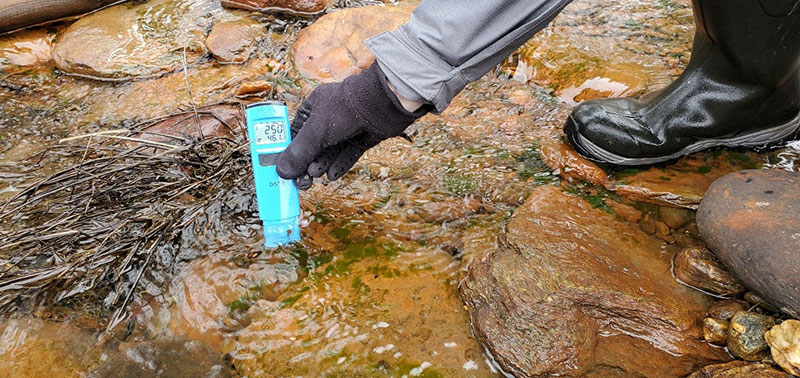On July 11 and 12, Friends of the Mad River’s (FMR) Mad River Watch volunteers visited field sites across The Valley in order to monitor water quality and make detailed environmental observations for their third field exploration this summer. This article is part of a series highlighting the questions and field work driving volunteers to find answers about the health of the Mad River watershed, as well as the community of supporters that make it possible.
CHANGING CLIMATE
Friends of the Mad River is incorporating conductivity measurements into its reimagined Mad River Watch program as part of a broader effort to understand the impacts of climate change in the watershed.
Over the last year, FMR staff and board have worked closely with a water quality scientist Becky Tharp of Just Water Consulting to ground the new program in sound scientific methods.
“Conductivity is a measure of the ability of water to pass an electrical current through it,” said Tharp. “The leading cause of increasing conductivity in freshwater ecosystems in Vermont is runoff from de-icing salts used on roads for winter maintenance (usually sodium chloride, NaCl).”
Increases in freeze-thaw cycles are associated with a changing climate and lead to more salt usage over the winter season. More extreme weather also means longer periods of drought during the summer, which can lead to dry and dusty dirt roads. “Calcium chloride (CaCl) salts are also used on Vermont roads in spring and summer to control dust. When the salt dissolves and is carried off of the roadway, it can enter streams and lakes, making the fresh water salty and increasing the conductivity,” explained Tharp.
On January 14, Kris Stepenuck, extension associate professor at UVM, joined the Ridge to River taskforce for a conversation and presentation on road salt. Stepenuck summarized the environmental, economic and social challenges, as well as the many uses for salt that keep our roads, parking lots, driveways and sidewalks safe during winter months. She also described best management practices that can be used to minimize the use of salt. A recording of this presentation can be found on Friends’ website -- Winter & Road Salt: A Ridge to River Investigation.
“Road salt fits into conversations this group has been having for a while,” said FMR director Corrie Miller “about the challenges local road crews and budget decision-makers face, the pros and cons of best management practices and the value of better understanding impacts on the Mad River.”
SALT IN THE WATERSHED
“A high conductivity level is not necessarily bad,” said Tharp. “Many things can influence a waterbody’s conductivity, including natural conditions like bedrock material. In most cases, conductivity in a waterbody will be consistent over time unless there is some change in the watershed.”
While it can be naturally occurring, excess salts from road runoff can negatively impact wildlife and freshwater ecosystems. High conductivity correlates well with salt concentration and, where conductivity or other pollutant measurements are high, FMR plans to follow up with further investigation to try and determine the source.
Volunteers use a digital probe to record highly accurate measurements of conductivity in the field. “Having these readings along the length of the Mad River will help us learn what the common conductivity levels are in the river,” said Miller. “This will allow us to track change over time and space -- so we can stop pollutant sources before they cause further damage.”
Once FMR has established some baseline data, volunteers will respond to high conductivity levels in the field by taking more readings upstream of the initial sampling site and, as needed, by taking a grab sample to be measured in a lab that will show exactly what’s causing the high readings.
HIGHLIGHTS FROM THE FIELD
Mad River Watch volunteers closely observe their field sites and sample water quality parameters like temperature, nitrate/nitrite, phosphate and conductivity in the field. This week saw 14 teams of volunteers visit 21 field sites.
The recent rain led to high water levels in the tributaries and the mainstem. Rainy weather can be a great time to observe the value of riparian buffers for reducing erosion. One volunteer noted that at the Ward Swim Access, “the area we typically stand to take measurements is now shallow water. The river seemed to be running faster. No major erosion on southeast bank and lots of vegetation to hold the bank in place, although it looks like more soil was exposed just above water height.”
Another volunteer reminds us that a single tree is not enough for a stable riparian buffer. At Mill Brook, “I’m about 10 to 20 yards downstream from where I’ve been testing, because a large portion of tree has come down in the place I’ve been testing.”
Over the summer, FMR will compile data and observations and share key findings and highlights in The Valley Reporter and online at friendsofthemadriver.org/madriverwatch.







